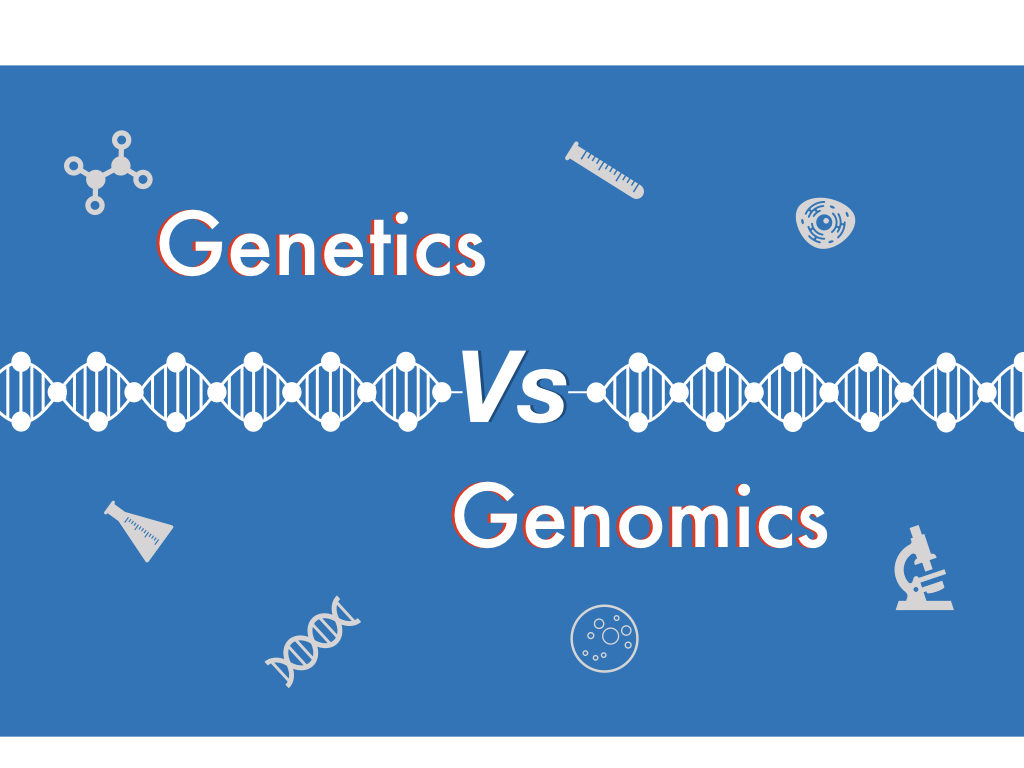“The study of genes, inheritance and their role in disease development are termed as genetics, while the study of the entire genome and its interaction with the environment is termed as genomics.”
For a beginner, both terms sound similar, however, the genetics and genomics are not synonyms of each other.
The technologies used in both the branches and the results out of it are different and thus used for different applications- broadly for genetic studies.
A DNA is an inheritance unit of us, in fact for all of us starting from single-cell prokaryotes to multicellular eukaryotes.
The functional piece of DNA is called a gene which encodes a particular protein for a particular function, though the major portion of our genome is non-coding.
Related article: Genome.
The genes are located on chromosomes, all the DNA located on all 23 chromosomes are called a genome. In humans 23 pairs of chromosomes are present, “a haploid set of chromosomes are called a genome.”
A single functional portion of a genome is called a gene while all the genes (with non-coding DNA) is called a genome.
In the present article, we are going to compare two of the almost similar terms: genetics vs genomics. This article will help you to understand, what exactly both terms are.
Genetics vs Genomics:
Genetics is a study of genes, a unit of inheritance and its effect on one’s health whereas the genomics is a study of all the genes and its interaction with the environment.
The world health organisation defines genetics as, “ the study of heredity” and genomics as, “ the study of all the genes, their function and related techniques.”
For examples, genetic disorders such as cystic fibrosis, thalassemia, sickle cell anaemia and Huntington’s disease can be studied using the genetic techniques while the complex disorders like cancer, diabetes and heart disease can be studies using the genomic techniques.
The term genetics was actually coined by Gregor Johann Mendel in 1865 while the term genomics was coined by Tom Rodericks in 1986.
Although both the terms were derived from the Greek word- “gen” which means birth or origin.
With the subfield of population genetics and epigenetics, genetics is a study of a single gene and its pattern of inheritance.
On the other side, the pleiotropy, epistasis and heterosis are commonly studied in genomics along with the genomic studies.
Both genetics and genomics studies are very important in health and disease diagnosis as well as screening.
However, the inheritance pattern of the (inherited)disease can be learned using genetic studies while multi genetic disorders can be identified using genomic techniques.
The multifactorial/ multigenic or complex genetic disorders arise due to alteration in many genes and its expression thus the inheritance pattern is unknown.
Tools like PCR and relate variation like nested PCR, touch down PCR, real-time PCR, ARMS PCR and hot-start PCR are used for diagnosis of single-gene disorders.
Thus PCR is one of the commonly used tools in genetic studies. In addition to this DNA sequencing and RFLP marker are also used for it.
On the other side,
Whole-genome sequencing, whole-chromosome microarray and SNP microarrays are employed for identification of either mutations or alterations associated with a complex genetic disorder.
Remember:
The alterations or mutations found in the complex genetic disorders are associated with the disease but not responsible for it.
Let’s take an example,
Autosomal recessive disorder thalassemia occurs due to the mutations IVS1-1, IVS1-5, CD8/9 or CD41/42. If any of the mutations present in a person, on both the chromosomes, it causes thalassemia.
This can easily be detected using the ARMS-PCR method. Read ARMS-PCR.
On the other side, cancer occurs due to adverse lifestyle of a person. Smoking, drinking alcohol and consumption of tobacco and related products are a common cause of cancer which mutates some of the genes or group of genes.
Some common cancer-causing genes are EGFR, ND1, ND5, COXI, COXII and COXIII etc involved in cancer. Mutations in any of the genes are commonly found in cancer but not necessarily responsible for it.
Genome-wide association studies are used for screening complex disorders.
This is the major difference between genetics and genomic studies.

Using simple methods like PCR and agarose gel electrophoresis with some simple computational sowftware the genetic study can be done. No fancy statistical analysis and computational tools are needed.
Contrary to this, the data outcome of the genomic studies is huge- nearly impossible to interpret without computational tools like bioinformatics.
Enormous data generated from the genomic studies are analysed using the bioinformatic and biostatistical tools.
For example, 34gb result data are generated after the next-generation sequencing analysis, a supercomputer is required to process the data.
Nearly, 20,000 to 25,000 genes are identified and known to us mutations in it are responsible for different diseases and inherited differently. Some are inherited as autosomal dominant while some are inherited as X-linked dominant.
Related article: Genetics Basics: A Beginners Guide To Learn Genetics.
The inheritance pattern of genes and related disease are known thus a genetic counsellor can help families to prevent disease.
The genomics is a newer field of science, many genomes can not be sequenced and compared using the genomic tools.
The genomic techniques are used in proteomics, transcriptomics and pharmacogenomics studies.
Proteomics- a subfield of genomics- studies proteins at large scale.
Transcriptomics is a study of the expression of all genes present in a cell. The entire set of mRNA of a genome is called transcriptomes.
Pharmacogenomics studies variations within a genome with respect to certain drugs or medications.
Conclusion:
For gene therapy and gene editing, genomic technique are used so often nowadays. Because it has the power to analyse many genes at a time.
However, conventional PCR and real-time PCR like techniques are the first choices for genetic laboratory.
Sources:


